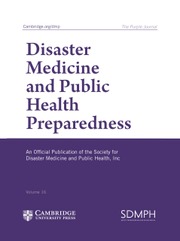No CrossRef data available.
Article contents
Hazard Vulnerabilities Analysis in the Low-Resourced Global Setting
Published online by Cambridge University Press: 02 April 2025
Abstract
A hazard vulnerabilities analysis (HVA) is an exercise used by institutions to identify potential threats and is required for credentialing hospitals in the US. To date, there is no documentation of HVA completion in low/middle income countries (LMIC) in the literature. American physicians working together with local physicians and staff from a major referral hospital in Addis Ababa, Ethiopia conducted an HVA in the LMIC setting. Using the Kaiser HVA template, the tool and exercise were tailored to the needs and resources of the LMIC setting. The exercise prompted rich discussion and facilitated the development of a framework to address local hospital threats. Many threats were considered sub-acute or chronic problems that had potential to acutely worsen, putting hospital operations and patient care in jeopardy and impacting staff. Ongoing threats were addressed creatively by the hospital administration, caregivers, and staff, a testament to the resiliency of the system and those working in it. Nonetheless, the hospital benefited from the HVA framework to improve future preparedness. Conducting an HVA in the LMIC setting is feasible, and this example can serve as a basis for HVA completion by other hospitals in similar settings.
- Type
- Brief Report
- Information
- Copyright
- © The Author(s), 2025. Published by Cambridge University Press on behalf of Society for Disaster Medicine and Public Health, Inc


